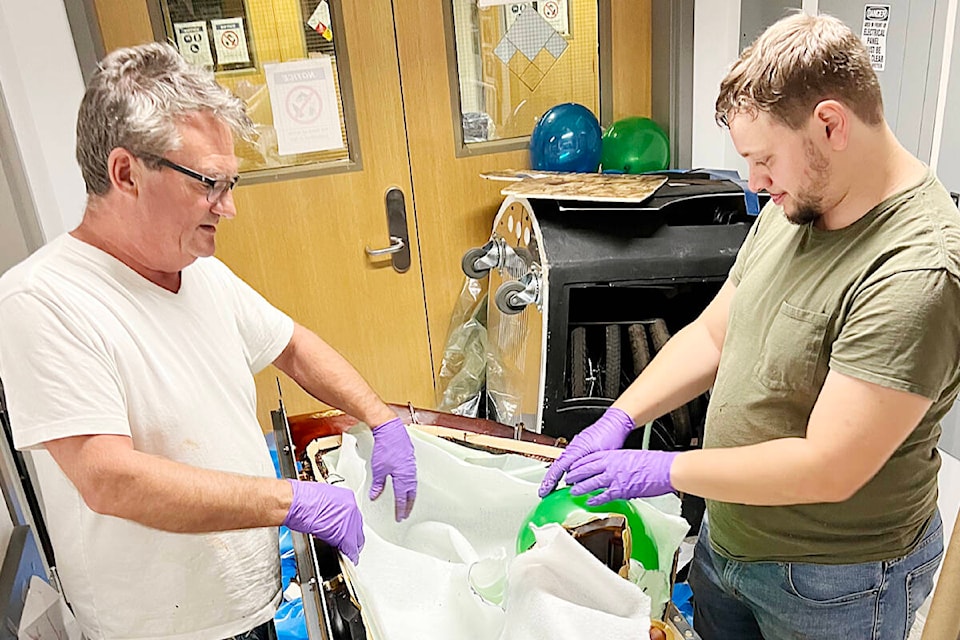A little-known company in Pitt Meadows is trying to raise money to build the first hurricane-resistant, electricity-supplying canopy, made entirely of sustainable composite materials – destined for the Bahamas.
The canopy would be able to provide electricity for communication following a major weather event, in addition to fresh water to drink from the humidity in the air, and lighting.
It would be able to withstand the wind gusts from a category five hurricane – the highest category on the Saffir-Simpson hurricane wind scale –and work after being totally submerged in salt water.
For the rest of the year the structure would provide much-needed shade and renewable energy to the local grid.
The structure itself resembles a tree – a trunk supporting 12 solar panels at the top.
Derrick Garland, CEO of Terrasol Energy, said the project began about eight years ago. He was installing solar panels in the Bahamas, but he found a lot of people were very apprehensive about installing them on their homes, because they were afraid they would just blow off in a hurricane and destroy their homes.
Owners of resort hotels didn’t like the look of them on their roofs.
According to WorldData.info, hurricanes occur frequently in the Bahamas but do not often make landfall. On average the area will see about seven hurricanes a year but turn away from the island beforehand. However, the remnants cause gusts of wind and rain. This year the island was hit by Franklin, a category four hurricane that reached wind speeds up to 241 km/h but only 93 km/h when it hit land. One of the most severe hurricanes that made landfall in the Bahamas in the past year was Nicole, a category one hurricane which hit on Nov. 9, 2022, with wind speeds on land up to 120 km/h, and the diameter when it made landfall was 220 kilometres.
So, the Pitt Meadows resident – who started his company Terrasol in 2008 in Langley and moved it to Pitt Meadows in 2018 – went on a mission, examining different materials on the market, to see if he could boost his sales. But, he couldn’t find anything that could handle the power of the wind in a hurricane, in addition to being submersible in salt water, and large enough to provide enough power to a home.
Then he came up with the idea of a solar canopy. Something that could attach to the ground, instead of a structure.
“It’s designed to stand in parking lots and provide shade for some things like parking and a number of other different things,” Garland said, noting the power that it will provide to the grid would be a source of revenue to local government. It would also supply LED lighting, security cameras could be mounted, and the canopy could also be used for advertising.
As it makes electricity, the canopy will be able to power battery systems for emergency services, EMS and the hospitals, police stations, he explained.
But he had to figure out what kind of material to use to make it durable.
READ ALSO: New invention from UBC Okanagan detects airborne viruses, like COVID
Garland reached out to the Composites Research Network in the Faculty of Applied Science at the University of British Columbia, first the Vancouver site and then the Okanagan Laboratory.
They came up with the idea of using bio fibre, or plant fibre, for the exterior structures.
Garland can’t say what exactly the fibre is he will be using, because the canopy is patent pending, but, he said, it is legal everywhere in the world, unlike hemp, and it can be grown in Canada.
“We needed a product that would be acceptable worldwide, completely sustainable – we could grow it in Canada,” said Garland, adding that in addition, when mixed with another plant polymer, it will have strength.
“If we can grow it then we can build something out of it,” he said.
The materials have undergone testing in an autoclave, a machine used in processes requiring high temperatures and pressure – testing that Garland described as perfect.
Using 3D printing systems the team was able to create molds of different aspects of the structure.
Now Garland is trying to raise $500,000 to build the canopy.
ALSO: One of the inventors of the calculator dies
A single canopy is expected to produce 10 kilowatts per hour of energy. A typical house in Canada, noted Garland, uses four kilowatts per hour.
So, he said, two houses could run for a whole day off of one canopy.
Each canopy will have four metres of clearance for vehicles under each one. The canopy will be about four and a half metres across. And, each one will weigh not more than 75 pounds.
Currently Garland said he is putting his own money into this venture and has no government funding because, he said, they require a working prototype.
However, he is still hoping to have the first one in the ground in the Bahamas in August, 2024. He already has a resort lined up for the first one.
For now his team just needs money to build.
“We’ve done all our engineering, we’ve done all our research, we’ve done all our market assessments,” he said.
“Absolutely I have the best people working for me for very little money,” he said about the UBC students in the Okanagan and Vancouver who are helping him.
“These people it’s a work of passion for them,” he said. “They can’t wait to see it in the ground.”
To donate to the project go to gofundme.com/f/hurricane-resilient-solar-electric-canopy.
